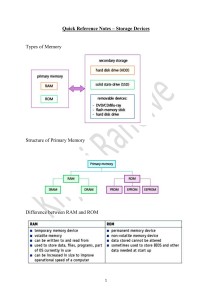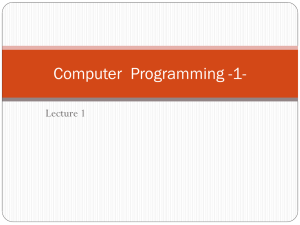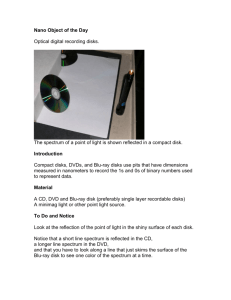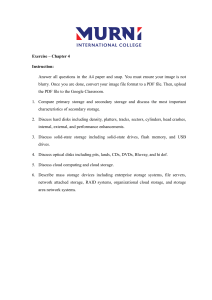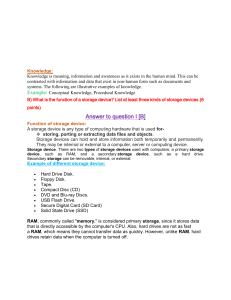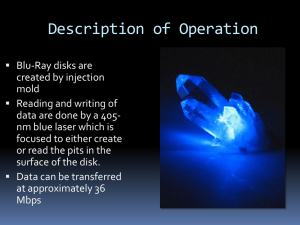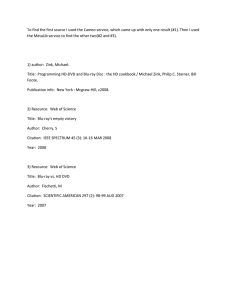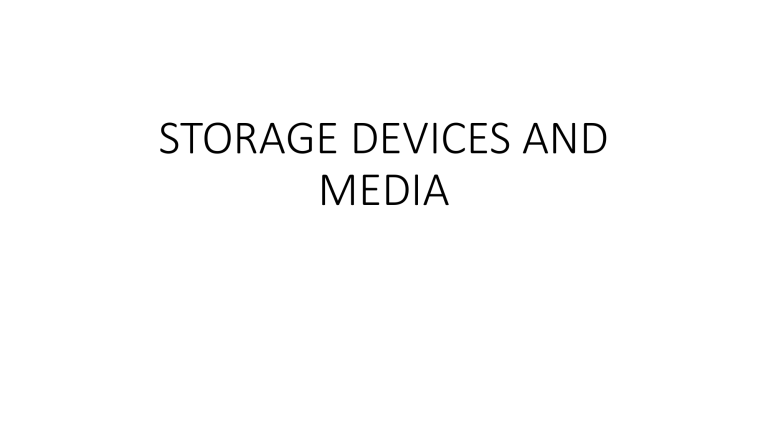
STORAGE DEVICES AND MEDIA Overview ★ storage devices: – magnetic (hard disk drive (HDD) and magnetic tape drive) – optical (CD, DVD and Blu-ray read/write devices) – solid state (solid-state drive (SSD), pen drive and flash drive) ★ storage media: – magnetic media (magnetic disks and magnetic tape) – optical (CD, DVD and Blu-ray discs) – solid state (including SD, XD and CFast) • Secondary storage includes all non-volatile devices that are not part of primary memory. They allow data to be stored as long as required by the user. All applications, the operating system, device drivers and general files (for example, documents, photos and music) are stored in secondary storage. There are three different categories of secondary storage which are based on technology that uses the following media: • Magnetic • Optical • Solid state. • It is very important to distinguish between the terms storage media and storage device. Media is the hardware on which the data is actually stored (for example, a CD or a DVD); whereas the storage device is the hardware used to read from or write to the media (for example, a CD/DVD reader or writer). Magnetic media and magnetic storage devices Magnetic media rely on the property that an iron oxide coating can be magnetized to represent a binary 1value and demagnetized to represent a binary 0-value. The two most common devices that use these magnetic properties to store data are Magnetic tape drives and Hard Disk Drives (HDD). Magnetic tape drives • A magnetic tape is a very thin strip of plastic which is coated in a magnetic layer (iron oxide). They are read from or written to by a read/write head in a magnetic tape storage device. Data is read from the tape using serial access (in other words, data can only be read in the same order that it was written). This type of storage is useless in real-time or online applications (due to the very slow data access speeds) and is best suited to offline or batch processing. USES OF MAGNETIC TAPE » Use in applications where batch processing is used (for example, clearing bank cheques, utility billing and producing pay slips). In these applications there is no need for any specific processing order and speed of data access is not essential). » Used as a backup media where vast amounts of data need to be stored. » Used in long-term archiving of data; magnetic tapes have huge data storage capacities and are known to be very stable, which makes them ideal for long-term storage. Advantages of magnetic tapes » They are generally less expensive (per byte) than the equivalent hard disk drive. » It is a very robust technology (they do not deteriorate much over time and remain stable). » They have a huge data storage capacity. » The data transfer rate is actually fast (this should not be confused with data access time which is very slow for magnetic tapes). Disadvantages of magnetic tape » Very slow data access times (they use serial access, which means all the previous data needs to be read until the required data is found) » When updating, another tape is needed to store the final updated version; this requires the use of a master tape (the original tape) and a transaction tape (which contains all the changes to be made) to produce a new master tape. This is clearly a slow way of updating data, and can also introduce errors, which is why magnetic tapes are no longer a common method of storing data). » They are affected by magnetic fields; a strong magnet (for example, one found in a loudspeaker) can corrupt data stored on the tape. Hard disk drives (HDD) • Hard disk drives (HDD) Data is stored in a digital format on the magnetic surfaces of the hard disks or platters. A hard disk drive will very often have more than one platter depending on its capacity. A number of read/write heads can access all of the platter surfaces in the disk drive (normally each platter will have two surfaces where the data is stored). These read/write heads can move very quickly – typically they can move from the center of the disk to the edge of the disk (and back again) 50 times a second. Data on an HDD can be read using direct access –this means, unlike magnetic tape, earlier data does not have to be read first before the required data is found. HOW HDD WORKS » Actuators are used to move the read/write heads » A read/write arm swings the read/write head back and forth across the platter; the platter is rotating at up to 10,000 rpm (revolutions per minute). » Each read/write head contains a tiny magnet which allows the data on the platter to be read. » Platters are made from glass, ceramic or aluminium which are coated in iron oxide. » There are two read/write heads per platter (one for the top surface and one for the bottom surface). » Data is stored in concentric, circular tracks; each track is broken up into sectors » A map of the sectors is stored on the HDD and is known as a file allocation table (FAT); when the computer wants to store new data, it looks at the FAT map to find out which sectors are free and then moves the read/write heads to the correct location – this greatly speeds up the writing process. Uses of fixed hard disk drives » To store the operating system, systems software and working data/files. » Storing applications software. » Used in real-time systems (for example, robots, control of a chemical plant) and in online systems (for example, booking airline tickets, automatic stock control (using EPOS)). » Used in file servers for computer networks. Advantages of fixed hard disk drives » They have a very fast data transfer rate and fast access times to data. » They have very large memory capacities. DISADVANTAGES OF FIXED HARD DISK DRIVES » They can be fairly easily damaged (for example, if the correct shut-down procedure on a computer has not been correctly carried out, it is possible to sustain a head crash). » They have many moving parts which can affect their overall reliability. » Their read/write operation can be quite noisy when compared to solid-state drives. Portable hard disk drives Portable hard disk drives are essentially HDDs external to the computer and can be connected to the computer using one of the USB ports. In this way, they can be used as a backup device or another way of transferring files between computers. USES OF PORTABLE HARD DISK DRIVES » They can be used as backup systems to prevent loss of data. » They can be used to transfer data/files/software between computers. ADVANTAGES OF PORTABLE HARD DISK DRIVES » The data access time and data transfer rate are very fast. » They have a large memory capacity. » They can be used as a method of transferring information between computers. DISADVANTAGES OF PORTABLE HARD DISK DRIVES » As with fixed disk drives, they can be easily damaged if the user accidentally drops it or does not correctly shut down the drive after use. » Data transfer rate is not as fast as for fixed hard drives. OPTICAL MEDIA AND OPTICAL STORAGE DEVICES CDs and DVDs are examples of optical media that may be read or written to by optical storage devices. Optical storage devices can be incorporated inside computers or linked to them outside via a USB cable. They rely on the optical characteristics of laser light, which is used to read and write data on the disk's surface. CDs and DVDs can be designated as: ‘R’ (write once only), ‘RW’ (can be written to or read from many times) or ‘ROM’ (read-only). Both CDs and DVDs use a thin layer of metal alloy or a lightsensitive organic dye coating to store the data. Both CDs and DVDs use a thin layer of metal alloy or a light-sensitive organic dye coating to store the data. Both systems rely on a single spiral track that goes from the center of the disk to the edge. An optical head in the drive unit moves to the beginning of the track as the disk rotates. The laser beam then travels outward from the center along the spiral track. The read/write head never makes physical contact with the CD or DVD surface. A CD/DVD is divided into sectors, allowing direct access of data. On the spiral track, data is kept in pits and lands (lands are the spaces between pits). The data is read and written using a red laser. These holes are only around 20% the depth of the wavelength of the laser light needed to read the disc. This indicates that the wavelength of the reflected laser light differs slightly from the wavelength of the original laser light, resulting in destructive interference. This enables pits and lands to be read and translated into binary data. USES OF CD-R AND DVD-R » Home recordings of music (CD-R) and films (DVD-R). » Used to store data to be kept for later use or to be transferred to another computer. USES OF CD-RW/DVD-RW » Used to record television programmes which can be recorded over, time and time again (although increasingly replaced by HDD recording systems). » Used in CCTV systems. » Can be used as a backup device for files and data. ADVANTAGES OF CD-RW/DVD-RW » Can be written over many times. » Can use different file formats each time it is used. » Not as wasteful as R format because the files/data can be added at a later stage (with CD-R/DVD-R it is only possible to do a write operation at the time and you cannot come back a few days later to add more files). DISADVANTAGES OF CD-RW/DVD-RW » Can be relatively expensive media. » Possible to accidentally overwrite data. Uses of CD-ROM/DVD-ROM » These optical disks are read-only memory (ROM) which means they cannot be written over and can only be read. They are a permanent method of data storage. » CD-ROM is used to store music files and to store software, computer games and reference software (such as an encyclopaedia). » DVD-ROM has much larger storage and is used to store films; but now it is increasingly used to store computer data and the evermore sophisticated games. » CD-ROMs and DVD-ROMs are used in applications where there is a real need to prevent the deletion or overwriting of important data. ADVANTAGES OF CD-ROM/DVD-ROM » They are less expensive than hard disk drive systems. DISADVANTAGES OF CD-ROM/DVD-ROM » The data transfer rate/data access time is slower than for hard disks. It should also be noted that there is another type of DVD, called DVD-RAM. It is constructed and operates differently to the other DVD formats and has been used as RAM in computers and camcorders. The format is now quite old. ADVANTAGES OF CD-R AND DVD-R » Cheaper medium than RW disks. » Once burned (and finalised) they behave like a ROM. DISADVANTAGES OF CD-R AND DVD-R » Can only be recorded once; if an error occurs then the disk has to be thrown away. » Not all CD/DVD players can read CD-R/DVD-R. Blu-ray discs Blu-ray discs are another example of optical storage media. However, they are fundamentally different to DVDs in their construction and in the way they carry out read/write operations. Blu-ray discs are read from or written to using a Blu-ray optical storage device. DIFFERENCES between DVD and Blu-ray » A blue laser, rather than a red laser, is used to carry out Blu-ray read and write operations; the wavelength of blue light is only 405 nanometres (compared to 650 nm for red light). » Using blue laser light means that the pits and lands can be much smaller;consequently, Blu-ray can store up to five times more data than normal DVD. » Blu-ray disks automatically come with a secure encryption system which helps to prevent piracy and copyright infringement. » The data transfer rate for a DVD is 10 Mbps and for a Blu-ray disc it is 36 Mbps CAPACITY AND INTERACTIVITY OF DVDS AND BLU-RAY DISCS » A standard single-layer DVD has a storage capacity of 4.7 GB (enough to store a two-hour standard definition movie). » A single-layer Blu-ray disc has a storage capacity of 27 GB (enough to store a two-hour high definition movie or 13 hours of standard definition movies). » A dual-layer Blu-ray disc has a storage capacity of 50 GB (enough to store 4.5 hours of high definition movies or 20 hours of standard definition movies). » Blu-ray devices allow greater interactivity than DVD devices. For example with Blu-ray, it is possible to: – record high definition television programmes – skip quickly to any part of the disc – create playlists of recorded movies and television programmes – edit or re-order programmes recorded on the disc – automatically search for empty space on the disc to avoid over-recording – access websites and download subtitles and other interesting features. DISK TYPE LASER COLOUR WAVELENGHT OF LASER LIGHT DISK CONSTRUCTION TRACK PITCH(DISTANCE BETWEEN TRACKS CD RED 780 NM SINGLE 1.2MM 1.6 μm POLUCARBONATE LAYER DVD (DUAL LAYER RED 650 NM TWO 0.6 MM POLYCARBONATE LAYER 0.74 μm BLU-RAY(SINGLE LAYER BLUE 405 NM SINGLE 1.2MM POLYCARBONATE LAYER 0.30 μm BLU-RAY (DUAL LAYER BLUE 405 NM TWO 0.6 MM POLYCARBONATE LAYERS 0.30 μm Uses of Blu-ray discs » Home video consoles. » Storing and playing back movies (one high definition movie of two hours duration uses up 25 GB of memory). » Computers can use this technology for data storage or backing up hard drives. » Camcorders can use this media (in cartridge form) to store movies ADVANTAGES OF BLU-RAY DISCS » Very large storage capacity, therefore ideal for storing high definition movies. » Very fast data transfer rate. » The data access speed is also greater than with other optical media. » Blu-ray discs automatically come with a secure encryption system, which helps to prevent piracy and copyright infringement. DISADVANTAGES OF BLU-RAY DISCS » Relatively expensive discs. » Encryption problems (which are used to stop piracy) when used to store video. » Introduction of HD (high definition) DVD players has reduced the advantages of using Blu-ray disc technology SOLID-STATE MEDIA AND SOLID-STATE STORAGE DEVICES Solid-state technology does not have latency because it does not rely on magnetic properties and they have no moving parts. The most common type of solid-state technology stores data by controlling the movement of electrons within NAND chips. The data is stored as 0s and 1s in millions of tiny transistors (at each junction one transistor is called a floating gate and the other is called a control gate) within the chip. This effectively produces a non-volatile rewritable memory. Devices that use solid-state technology in this way are often referred to as flash memories or flash drives. SOLID-STATE DRIVES (SSD) Use solid-state media and can be used in the same way as an HDD. They have enabled laptop computers to become thinner and much lighter. They have given rise to the development of smartphones and tablets; without solid-state technology, these devices simply would not exist. ADVANTAGES OF SSDS » they are more reliable (no moving parts to go wrong) » they are considerably lighter (which makes them suitable for laptops) » they do not have to ‘get up to speed’ before they work properly » they have a lower power consumption » they run much cooler than HDDs » because of no moving parts, they are very thin » SSD data access time is only 0.1 milliseconds compared to 10 milliseconds for HDD » data transfer speed for SSDs is also much faster than for HDDs. Disadvantages of SSDs The main drawback of SSDs is the longevity of the technology (although this is becoming less of an issue). Most solid-state storage devices are conservatively rated at only 20 GB write operations per day over a three-year period – this is known as SSD endurance. For this reason, SSD technology is still not used in all servers, for example, where a huge number of write operations take place every day.
